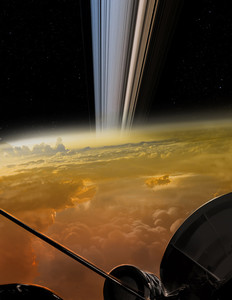A spacecraft to Saturn launched in 1997 October, jointly built by NASA, ESA, and the Italian Space Agency. It consisted of two parts: the Cassini orbiter, and the Huygens lander to study Saturn’s largest satellite, Titan. Cassini–Huygens went into orbit around Saturn in 2004 July, having undergone two gravity-assist flybys of Venus and one each of the Earth and Jupiter en route; it made observations of Jupiter during its encounter in 2000 December. Huygens landed on Titan in 2005 January, measuring atmospheric conditions during its descent and transmitting from the surface for over an hour. The Cassini orbiter studied Saturn’s atmosphere, rings, and satellites, including fly-bys of Titan and Enceladus, until 2017 September.
http://saturn.jpl.nasa.gov/ Official mission website.
http://sci.esa.int/cassini-huygens/ ESA mission website.
A space probe developed jointly by NASA and the European Space Agency to explore the planet Saturn. Cassini was launched on 15 October 1997 to study the planet's atmosphere, rings, and moons, and to drop off a sub-probe, Huygens, to land on Saturn's largest moon, Titan. The spacecraft entered orbit around Saturn on 1 July 2004 and Huygens was released on 25 December, reaching the surface of Titan on 14 January 2005.
After almost 20 years in space, Cassini made its final close approach to Titan, passing 979 km from its surface on 21 April 2017. The flyby also put Cassini on course for its dramatic last act, known as the Grand Finale—a series of 22 dives between the rings and the planet five days later. After spending 13 years in orbit around the planet, the mission intentionally ended on 15 September 2017; the spacecraft was running low on fuel and NASA scientists needed to use that energy to readjust the craft’s orbit so that it would not collide with Saturn’s moons Enceladus or Titan, which appear to have prebiotic environments. Before its demise, Cassini sent back data taken with eight of its instruments from within Saturn’s atmosphere for about a minute between entry and loss of signal. Among these data was a new phenomenon called ‘ring rain’. The spacecraft’s last signal was received by NASA’s Deep Space Network antenna complex in Canberra, Australia, before it was lost at 4:55 am Pacific daylight time.
The Cassini–Huygens mission was launched on a Titan 4 rocket, with its electricity supplied by 32 kg of plutonium. This was the largest amount of plutonium ever to be sent into space, and provoked fears of contamination should Cassini, or its rocket, malfunction.

This artist’s concept shows an over-the-shoulder view of NASA’s Cassini spacecraft making one of its Grand Finale dives over Saturn, before it plunges into the planet’s atmosphere.
Credit: NASA/JPL-Caltech
https://www.nasa.gov/mission_pages/cassini/main/index.html Well-organized site documenting the Cassini–Huygens mission to Saturn. There is an impressive gallery featuring pictures returned by the spacecraft, time-lapse movies, and animations. There are also interesting details of what is already known about Saturn's moons.
- aerobraking
- aerodynamic drag
- aerodynamic roughness
- aerodynamics
- aerogel
- aerogenerator
- aerolite
- aerological diagram
- aeromagnetic survey
- aeronautics
- Aeronian
- aeronomy
- Aeronomy of Ice in the Mesosphere
- aeroplane
- aeroshell
- aerosol
- aerospace
- Aerospace Directing and Controlling Centre
- Aerospike
- aerotaxis
- aerotolerant
- AES
- Aesop (6th)
- Ae star
- aesthetic